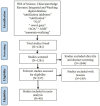A meta-analysis to examine whether nitrification inhibitors work through selectively inhibiting ammonia-oxidizing bacteria
- PMID: 35928162
- PMCID: PMC9343776
- DOI: 10.3389/fmicb.2022.962146
A meta-analysis to examine whether nitrification inhibitors work through selectively inhibiting ammonia-oxidizing bacteria
Abstract
Nitrification inhibitor (NI) is often claimed to be efficient in mitigating nitrogen (N) losses from agricultural production systems by slowing down nitrification. Increasing evidence suggests that ammonia-oxidizing archaea (AOA) and ammonia-oxidizing bacteria (AOB) have the genetic potential to produce nitrous oxide (N2O) and perform the first step of nitrification, but their contribution to N2O and nitrification remains unclear. Furthermore, both AOA and AOB are probably targets for NIs, but a quantitative synthesis is lacking to identify the "indicator microbe" as the best predictor of NI efficiency under different environmental conditions. In this present study, a meta-analysis to assess the response characteristics of AOB and AOA to NI application was conducted and the relationship between NI efficiency and the AOA and AOB amoA genes response under different conditions was evaluated. The dataset consisted of 48 papers (214 observations). This study showed that NIs on average reduced 58.1% of N2O emissions and increased 71.4% of soil concentrations, respectively. When 3, 4-dimethylpyrazole phosphate (DMPP) was applied with both organic and inorganic fertilizers in alkaline medium soils, it had higher efficacy of decreasing N2O emissions than in acidic soils. The abundance of AOB amoA genes was dramatically reduced by about 50% with NI application in most soil types. Decrease in N2O emissions with NI addition was significantly correlated with AOB changes (R 2 = 0.135, n = 110, P < 0.01) rather than changes in AOA, and there was an obvious correlation between the changes in concentration and AOB amoA gene abundance after NI application (R 2 = 0.037, n = 136, P = 0.014). The results indicated the principal role of AOB in nitrification, furthermore, AOB would be the best predictor of NI efficiency.
Keywords: DMPP; ammoxidation; edaphic conditions; microorganism; nitrous oxide.
Copyright © 2022 Lei, Fan, Yu, Ma, Yin and Liu.
Conflict of interest statement
The authors declare that the research was conducted in the absence of any commercial or financial relationships that could be construed as a potential conflict of interest.
Figures




Similar articles
-
Meta-analysis of the effect of nitrification inhibitors on the abundance and community structure of N2O-related functional genes in agricultural soils.Sci Total Environ. 2023 Mar 20;865:161215. doi: 10.1016/j.scitotenv.2022.161215. Epub 2022 Dec 28. Sci Total Environ. 2023. PMID: 36584958
-
Effects of nitrogen application rate and a nitrification inhibitor dicyandiamide on ammonia oxidizers and N2O emissions in a grazed pasture soil.Sci Total Environ. 2013 Nov 1;465:125-35. doi: 10.1016/j.scitotenv.2012.08.091. Epub 2012 Sep 25. Sci Total Environ. 2013. PMID: 23021462
-
Niche Differentiation Among Canonical Nitrifiers and N2O Reducers Is Linked to Varying Effects of Nitrification Inhibitors DCD and DMPP in Two Arable Soils.Microb Ecol. 2023 May;85(4):1434-1447. doi: 10.1007/s00248-022-02006-8. Epub 2022 Apr 14. Microb Ecol. 2023. PMID: 35420314
-
Improving Nitrogen Use Efficiency in Aerobic Rice Based on Insights Into the Ecophysiology of Archaeal and Bacterial Ammonia Oxidizers.Front Plant Sci. 2022 Jun 13;13:913204. doi: 10.3389/fpls.2022.913204. eCollection 2022. Front Plant Sci. 2022. PMID: 35769304 Free PMC article. Review.
-
Nitrous oxide production by ammonia oxidizers: Physiological diversity, niche differentiation and potential mitigation strategies.Glob Chang Biol. 2020 Jan;26(1):103-118. doi: 10.1111/gcb.14877. Epub 2019 Nov 29. Glob Chang Biol. 2020. PMID: 31638306 Review.
Cited by
-
Benefits and limits of biological nitrification inhibitors for plant nitrogen uptake and the environment.Sci Rep. 2024 Jul 1;14(1):15027. doi: 10.1038/s41598-024-65247-2. Sci Rep. 2024. PMID: 38951138 Free PMC article.
-
Soil Factors Key to 3,4-Dimethylpyrazole Phosphate (DMPP) Efficacy: EC and SOC Dominate over Biotic Influences.Microorganisms. 2024 Aug 29;12(9):1787. doi: 10.3390/microorganisms12091787. Microorganisms. 2024. PMID: 39338462 Free PMC article.
-
The addition of discrimination inhibitors stimulations discrimination potential and N2O emissions were linked to predation among microorganisms in long term nitrogen application and straw returning systems.Front Microbiol. 2024 Jan 9;14:1337507. doi: 10.3389/fmicb.2023.1337507. eCollection 2023. Front Microbiol. 2024. PMID: 38264480 Free PMC article.
-
Inhibition profile of three biological nitrification inhibitors and their response to soil pH modification in two contrasting soils.FEMS Microbiol Ecol. 2024 May 14;100(6):fiae072. doi: 10.1093/femsec/fiae072. FEMS Microbiol Ecol. 2024. PMID: 38702852 Free PMC article.
References
-
- Ai C., Liang G., Sun J., Wang B., He P., Zhou W. (2013). Different roles of rhizosphere effect and long-term fertilization in the activity and community structure of ammonia oxidizers in a calcareous fluvo-aquic soil. Soil Biol. Biochem. 57 30–42. 10.1016/j.soilbio.2012.08.003 - DOI
-
- Azam F., Benckiser G., Müller C., Ottow J. C. G. (2001). Release, movement and recovery of 3, 4-dimethlpyrazole phosphate(DMPP), ammonium and nitrate from stabilized nitrogen fertilizer granules in a soil under laboratory conditions. Biol. Fertil. Soils 34 118–125. 10.1007/s003740100384 - DOI
-
- Barth G., Tucher S. V., Schmidhalter U. (2008). Effectiveness of 3, 4-dimethylpyrazole phosphate as nitrification inhibitor in soil as influenced by inhibitor content, application form, and soil matric potential. Pedosphere 18 378–385. 10.1016/S1002-0160(08)60028-4 - DOI
LinkOut - more resources
Full Text Sources

